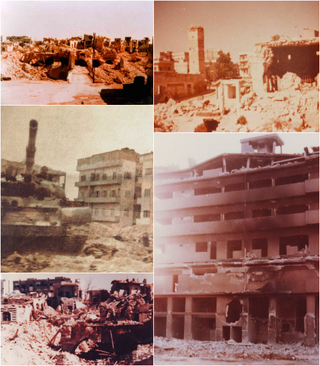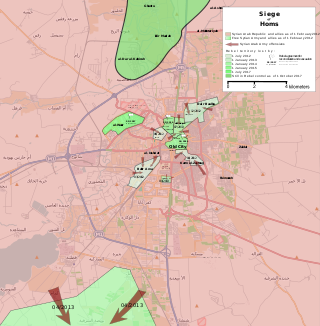
The Hama massacre occurred in February 1982 when the Syrian Arab Army and the Defense Companies, under orders of president Hafez al-Assad, besieged the town of Hama for 27 days in order to quell an uprising by the Muslim Brotherhood against the Ba'athist government. The campaign that had begun in 1976 by Sunni Muslim groups, including the Muslim Brotherhood, was brutally crushed in an anti-Sunni massacre at Hama, carried out by the Syrian Arab Army and Alawite militias under commanding General Rifaat al-Assad.
Terrorism in Syria has a long history dating from the state-terrorism deployed by the Ba'athist government since its seizure of power through a violent coup in 1963. The Ba'athist government have since deployed various types of state terrorism; such as ethnic cleansing, forced deportations, massacres, summary executions, mass rapes and other forms of violence to maintain its totalitarian rule in Syria. The most extensive use of state terrorism in the 20th century was during 1970s and 1980s, when Islamic uprisings across Syria where crushed through bloody campaigns of intense repression, culminating in the 1982 Hama massacre which killed around 40,000 civilians.
Talkalakh is a city in western Syria administratively belonging to the Homs Governorate as the capital of the Talkalakh District just north of the border with Lebanon and west of Homs. According to the Central Bureau of Statistics (CBS) Talkalakh had a population of 18,412 in 2004. Its inhabitants are predominantly Sunni Muslims, while the surrounding villages are mostly inhabited by Alawites. Most of the city's Sunni Muslim residents have fled as a result of the ongoing Syrian civil war.
The following is a timeline of the Syrian Civil War from May to August 2011, including the escalation of violence in many Syrian cities.
The siege of Rastan and Talbiseh was an operation by the Syrian Army during the Syrian revolution. On 28 May 2011, after protests and an armed revolt, the Syrian Army launched an operation in al-Rastan, a city of an estimated 50,000 residents located 20 kilometers north of Homs, and the neighboring town of Talbiseh, which resulted in the suppression of the protests and numerous deaths. The Syrian Army met some armed opposition during the siege.

In June 2011, during the civil uprising phase of the Syrian Civil War, rebels seized the city of Jisr ash-Shughur, resulting in violent clashes with the Syrian security forces, including the military. The exact reasons of the fighting, the course of events, and the resulting destruction and deaths are disputed. The government claimed that it clashed with Islamist-leaning insurgents who had set up an ambush for security forces, while the Syrian opposition described the Jisr ash-Shughur clashes as crackdown against pro-democracy protesters, resulting in a mutiny among soldiers and a large battle with many people being massacred by pro-government forces. The fighting in the city lasted from 4 until 12 June 2011.
The following is a timeline of the Syrian uprising from September to December 2011. This period saw the uprising take on many of the characteristics of a civil war, according to several outside observers, including the United Nations Commission on Human Rights, as armed elements became better organized and began carrying out successful attacks in retaliation for the ongoing crackdown by the Syrian government on demonstrators and defectors.

The siege of Homs was a military confrontation between the Syrian military and the Syrian opposition in the city of Homs, a major rebel stronghold during the Syrian Civil War. The siege lasted three years from May 2011 to May 2014, and ultimately resulted in an opposition withdrawal from the city.

The September 2011 – March 2012 Idlib Governorate clashes were the violent incidents that took place in Idlib Governorate, a province of Syria, from September 2011 and prior to the April 2012 Idlib Governorate Operation.
The Battle of Zabadani took place in January through February 2012, during the Syrian Civil War. During the initial stages of the battle, the rebel FSA took control of the town. However, less than a month later, the Army retook control of Zabadani, forcing rebel fighters to withdraw towards the Lebanese border.
The Battle of Douma was a military engagement during the Syrian Civil War. The battle began on 21 January 2012, after Free Syrian Army fighters changed their tactics from attack and retreat guerrilla warfare in the suburbs of Damascus to all-out assault on army units. Earlier in January, the FSA had taken the town of Zabadani, and consequently gained control over large portions of Douma. After a general offensive in the suburbs, Douma was retaken by the Syrian army at the same time as the other rebelling suburbs.
The following is a timeline of the Syrian Civil War from May to August 2012. The majority of death tolls reported for each day comes from the Local Coordination Committees, an opposition activist group based in Syria, and the Syrian Observatory for Human Rights, another opposition group based in London.

War crimes in the Syrian civil war have been numerous and serious. A United Nations report published in August 2014 stated that "the conduct of the warring parties in the Syrian Arab Republic has caused civilians immeasurable suffering". Another UN report released in 2015 stated that the war has been "characterized by a complete lack of adherence to the norms of international law" and that "civilians have borne the brunt of the suffering inflicted by the warring parties". Various countries have prosecuted several war criminals for a limited number of atrocities committed during the Syrian civil war.
This page provides maps and a list of cities and towns during the Syrian civil war.
The following is a timeline of the Syrian Civil War from September to December 2012. Information about aggregated casualty counts is found at Casualties of the Syrian Civil War.
The siege of Daraa occurred within the context of the 2011 Arab Spring protests in Syria, in which Daraa was the center of unrest. On 25 April 2011, the Syrian Army began a ten-day siege of the city, an operation that helped escalate the uprising into an armed rebellion and subsequent civil war.
The following is a timeline of the Syrian civil war from May to December 2013. Information about aggregated casualty counts is found at Casualties of the Syrian Civil War.
The Bayda and Baniyas massacres were two widely reported massacres that occurred in May 2013 in the village of Bayda and the city of Baniyas, in Tartus Governorate, Syria, where Syrian Army troops, supported by paramilitaries, killed civilians in the predominantly Sunni locales. The killings were supposedly in retaliation for an earlier rebel attack near the town that left at least half a dozen soldiers dead.

The Syrian revolution, also known as the Syrian Revolution of Dignity, was the series of mass protests and uprisings – with subsequent violent reaction by the Syrian Arab Republic – lasting from March 2011 to June 2012, as part of the wider Arab Spring in the Arab world. The revolution, which demanded the end of the decades-long rule of Assad family, began as minor demonstrations during January 2011 and transformed into nation-wide mass protests in March. The uprising was marked by large-scale protests against the Ba'athist dictatorship of president Bashar al-Assad, meeting with police and military violence, massive arrests and a brutal crackdown, resulting in thousands of deaths and tens of thousands wounded.





